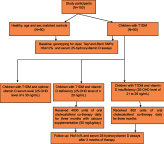Vitamin D receptor rs7975232, rs731236 and rs1544410 single nucleotide polymorphisms, and 25-hydroxyvitamin D levels in Egyptian children with type 1 diabetes mellitus: effect of vitamin D co-therapy
- PMID: 31190930
- PMCID: PMC6526182
- DOI: 10.2147/DMSO.S201525
Vitamin D receptor rs7975232, rs731236 and rs1544410 single nucleotide polymorphisms, and 25-hydroxyvitamin D levels in Egyptian children with type 1 diabetes mellitus: effect of vitamin D co-therapy
Abstract
Purpose: We aimed to examine the possible association role of vitamin D and vitamin D receptor (VDR) single nucleotide polymorphisms (SNPs) in type 1 diabetes mellitus (T1DM) development, glycemic control and complications among a cohort of Egyptian children. Subjects and methods: A prospective case-control study has been conducted on 50 Egyptian children with T1DM who were comparable with 50 controls. Vitamin D and HbA1c were measured. VDR-SNPs [ApaI (rs7975232), TaqI (rs731236) and BsmI (rs1544410)] detection was done by polymerase chain reaction through restriction fragment length polymorphism (PCR-RFLP) technique. Vitamin D supplements were given to the included T1DM children with low vitamin D and reassessments of both HbA1c% and 25(OH)D serum levels were performed in those children three months later. Results: Eighty percent of the included diabetic patients have poor glycemic control. Vitamin D was deficient in 68% and insufficient in 16% of diabetic patients. Significant improvements in both vitamin D and glycemic status among T1DM children, who have low vitamin D and received vitamin D supplementations. There were significantly negative correlations between serum levels of vitamin D with both HbA1c % (r= -0.358, P˂0.05) and daily insulin dose (r=-0.473, P˂0.05). Compared with controls, T1DM children presented more commonly with ApaI a allele (OR: 2.87; 95%CI: 1.39-5.91, P˂0.05) and BsmI b allele (OR: 4.38; 95%CI: 2.30-8.33, P˂0.05). TaqI t allele wasn't significantly differing among patients and controls (P˃0.05). Aa+aa and Bb+bb genotypes were significantly higher among T1DM vs the controls (OR: 3.08;, 95%CI: 1.33-7.15, P˂0.05 and OR: 9.33; 95%CI: 3.61-24.17, P˂0.05respectively). Conclusion: ApaI and BsmI were associated with risk of T1DM development among Egyptian children. Low vitamin D status was frequently occurring among T1DM with significant improvement in the glycemic control of such children when adding vitamin D supplements to the standard insulin therapy.
Keywords: Egyptian children; genomic DNA; type 1 diabetes mellitus; vitamin D; vitamin D receptor single nucleotide polymorphisms; vitamin D therapy.
Conflict of interest statement
The authors report no conflicts of interest in this work.
Figures





Similar articles
-
Assessment of vitamin D status and vitamin D receptor polymorphism in Egyptian children with Type 1 diabetes.J Genet Eng Biotechnol. 2024 Mar;22(1):100343. doi: 10.1016/j.jgeb.2023.100343. Epub 2024 Jan 22. J Genet Eng Biotechnol. 2024. PMID: 38494252 Free PMC article.
-
Vitamin D status and vitamin D receptor gene polymorphisms and susceptibility to type 1 diabetes in Egyptian children.Gene. 2014 Feb 25;536(2):430-4. doi: 10.1016/j.gene.2013.12.032. Epub 2013 Dec 23. Gene. 2014. PMID: 24370753
-
Relationship of four vitamin D receptor gene polymorphisms with type 1 diabetes mellitus susceptibility in Kuwaiti children.BMC Pediatr. 2019 Mar 7;19(1):71. doi: 10.1186/s12887-019-1448-0. BMC Pediatr. 2019. PMID: 30845908 Free PMC article.
-
Vitamin D receptor gene polymorphism in Egyptian pediatric acute lymphoblastic leukemia correlation with BMD.Meta Gene. 2016 Mar 30;9:42-6. doi: 10.1016/j.mgene.2016.03.008. eCollection 2016 Sep. Meta Gene. 2016. PMID: 27114922 Free PMC article. Review.
-
A meta-analysis of association of vitamin D receptor BsmI gene polymorphism with the risk of type 1 diabetes mellitus.J Recept Signal Transduct Res. 2014 Oct;34(5):372-7. doi: 10.3109/10799893.2014.903420. Epub 2014 Mar 25. J Recept Signal Transduct Res. 2014. PMID: 24665917 Review.
Cited by
-
Gastrointestinal Microbiota and Type 1 Diabetes Mellitus: The State of Art.J Clin Med. 2019 Nov 2;8(11):1843. doi: 10.3390/jcm8111843. J Clin Med. 2019. PMID: 31684011 Free PMC article. Review.
-
Pathophysiological Role and Therapeutic Implications of Vitamin D in Autoimmunity: Focus on Chronic Autoimmune Diseases.Nutrients. 2020 Mar 17;12(3):789. doi: 10.3390/nu12030789. Nutrients. 2020. PMID: 32192175 Free PMC article. Review.
-
Variants in the VDR Gene May Influence 25(OH)D Levels in Type 1 Diabetes Mellitus in a Brazilian Population.Nutrients. 2022 Feb 27;14(5):1010. doi: 10.3390/nu14051010. Nutrients. 2022. PMID: 35267984 Free PMC article.
-
Chinese Guidelines for Medical Nutrition Therapy for Patients with Diabetes (2022 Edition).Asia Pac J Clin Nutr. 2024 Jun;33(2):118-152. doi: 10.6133/apjcn.202406_33(2).0001. Asia Pac J Clin Nutr. 2024. PMID: 38794974 Free PMC article.
-
Associations between the VDR Gene rs731236 (TaqI) Polymorphism and Bone Mineral Density in Postmenopausal Women from the RAC-OST-POL.Biomedicines. 2024 Apr 20;12(4):917. doi: 10.3390/biomedicines12040917. Biomedicines. 2024. PMID: 38672272 Free PMC article.
References
-
- Nasreen M, Lone KP, Khaliq S. Serum vitamin D levels and gene polymorphisms (Fok1 and Apa1) in children with type I diabetes and healthy controls. J Pak Med Assoc. 2016;66:1215–1220. - PubMed
-
- Lipton RB, Drum M, Burnet D, et al. Obesity at the onset of diabetes in an ethnically diverse population of children: what doesit mean for epidemiologists and clinicians? Pediatrics. 2005;115:e553. - PubMed
-
- Panierakis C, Goulielmos G, Mamoulakis D, et al. Vitamin D receptor gene polymorphisms and susceptibility to type 1 diabetes in Crete Greece. Clin Immunol. 2009;133:276–281. - PubMed
-
- Uitterlinden AG, Fang Y, Van Meurs JB, et al. Genetics and biology of vitamin D receptor polymorphisms. Gene. 2004;338:143. - PubMed
LinkOut - more resources
Full Text Sources

